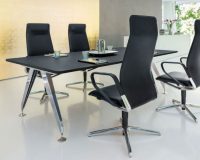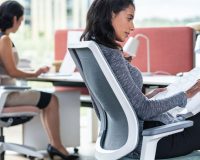What is ergonomics? It has become an office buzzword, and people love to talk about it—or the lack of it. According to the Cambridge English dictionary, ergonomics is an applied science concerned with how conditions affect a person’s efficiency in their working environment. (1) But that simple statement covers a lot of ground. Ergonomics aims to increase the productivity of and reduce discomfort for the people involved. We’ll look at this subject from different angles so you can see how your workplace can be arranged and furnished for maximum comfort and efficiency.
Who invented ergonomics?
The word “ergonomics” is derived from the Greek words “ergon,” meaning work, and “nomos,” meaning natural law. The English word was introduced by British psychologist K.F. Hywel Murrell at a meeting at the Admiralty in London in July 1949. (2) The term was officially accepted in Britain one year later. In 1952, Britain formed The Ergonomic Society. The United States followed shortly after, creating The Human Factors Society in 1957.
The foundations of the science of ergonomics seem to go far back into history. In the fifth century B.C., Hippocrates used ergonomic principles in describing a surgeon’s ideal workspace. He outlined the design and arrangement of tools during surgery to maximize safety and efficiency. Over the centuries, the effectiveness of simple tools like hammers, axes, and plows improved through design and usage protocols. The Industrial Revolution in the mid-19th century brought large-scale manufacturing while office work was growing dramatically. Ergonomic principles began to be applied with the goal of improving processes and production (although not necessarily worker well-being).
World War II increased interest in how humans and machines interacted. New, intricate, and sophisticated machines and weapons increased demands on their operators’ cognition and response time. A machine’s failure or success depended on an operator’s situational awareness, attention, coordination, and decision-making. The focus was to improve the machinery’s design to enhance these qualities for the operator.
Ergonomics proved to be especially valuable in reducing aircraft accidents that were being blamed incorrectly on pilot error. When displays and controls were made to be read and understood more easily, and were logically placed in cockpits, crashes due to “pilot error” were reduced. These innovations accelerated the drive for efficiency and safety in the relationship between humans and machines. Research on this continues today, including for military purposes. (3) Advances in ergonomics have progressed far beyond warfare and machines. The concept is critical to one of the most common modern workplaces: the office.
What are ergonomics in the workplace?
There are three main types of ergonomics, so let’s look at how they are applied in the work environment.
- Physical ergonomics covers how the human body functions and interacts with workplace tools and tasks. Office furniture design is an important part of office ergonomics.
- Cognitive ergonomics involves designing so that people can perceive, comprehend and remember information as easily as possible and give the best motor response. This discipline is used, for example, in computer interfaces and training programs.
- Organizational ergonomics applies to the organizational structure of the office as a whole—the building, its setup, the furniture arrangement, and how workers can move around their environment. How far is the copier from the person who uses it most? Is the office filled with cubicles and workers can barely find the conference room?
Environmental ergonomic design aims to create a cohesive physical office environment. This kind of space enables workers to increase efficiency in physical and mental processes and interact with each other.
The scientific discipline of ergonomics studies human factors like posture, physical activity, and repetitive movements. It seeks to understand how the human body generates each motor response within its environment. That includes things as seemingly simple as sitting in a chair. For example, an ergonomic swivel chair could allow for height adjustments so an employee could sit in the ideal position—feet flat on the ground at their desks as they work. If, instead, they cross their legs and rest them on an object in front of them, the blood vessels in their legs may become constricted. The ergonomic chair has been foiled.
All these different types of ergonomics come into play in the fabric of a workplace. When workers are mentally and physically comfortable, they’re much more likely to be productive in the short term. They also are more likely to stay at their company. Ergonomic office furniture is one of the best ways to create a safe work environment that prevents work-related injuries. Musculoskeletal disorders resulting from poor posture are a particular concern for office workers. Let’s consider how different types of office furniture can promote ergonomics.
Chairs
If you sit while you work, you likely use a chair (although an ergonomic stool is a good option). The ergonomics of your chair significantly impact your ability to do your job efficiently. Even the most well-designed chair is useless if it won’t adjust to the range of human anatomy. Therefore, adjustability is the key to an ergonomic chair. Office chairs with good ergonomics have features designed to improve posture and offer proper support. These include:
- Adjustable seat height
- Proper seat depth
- Adjustable seat tilt
- Lumbar support
- Backrest recline
- Swivel
- Armrests
- Comfortable materials
- Wheels
Ergonomic stools
Ergonomic stools are a compromise between sitting and standing at a desk. These stools combine comfort and ease while stimulating your metabolism. They promote active sitting—one of the keys to healthy ergonomics. Some things to look for in an ergonomic stool are:
- Proper seat width
- Sloping edges on the seat
- Adjustable height
- Even, rounded, rubber base allowing secure movement
Desks
Most office jobs require some kind of desk. But a static desk height can make it hard to engage in active sitting. This concept involves frequently changing your sitting position. But it also means alternating your working position between sitting and standing at a desk. An ergonomic desk should have:
- Adjustable height
- Sturdy legs
- Proper length and width that allow elbows to comfortably rest at 90 degrees
- Quality materials
What is ergonomics? The cornerstone of a good office!
Now that you know the ins and outs of ergonomics, check out the ergonomic office furniture solutions at Sedus. Whether you’re looking for desks, chairs, or conference room tables, Sedus has everything your office needs. Contact them today to find out how to use ergonomics to maximize the potential and profits of your business.
1 Cambridge English Dictionary
2 History of the Ergonomics Research Society
3 Emergency Services Ergonomics and Wellness







